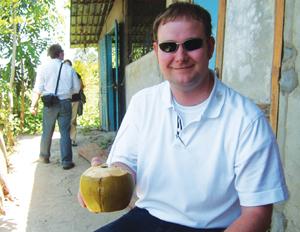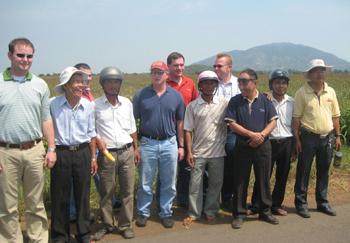A trip to Vietnam and South Korea is going to help farmers in Iowa expand their clientele.
 |
| Neil Bouray drinks the milk of a coconut while visiting Vietnam as part of an I-LEAD international agricultural mission. |
 |
| Members of the I-LEAD class stand with Vietnamese farmers. I-LEAD members pictured with Vietnamese farmers included Neil Bouray, far left, Kurt Hora, third from left (in back); and Chris Edginton, Klint Cork and Chris Veydert, center. Tran Trong Chien of the Vietnam grains council is third from the right. |
Neil Bouray of Randolph was among 20 Iowans who ventured to South Korea and Vietnam from March 11-22 to learn about current and emerging markets and infrastructure in international agriculture, specifically in corn, soybeans, pork and beef.
The trip was part of the Iowa Corn Leadership and Development program, a two-year program designed to provide men and women in agriculture the education and skills needed to succeed as leaders and spokespeople for the industry. The Iowa Corn Growers Association and the Iowa Corn Promotion Board sponsor I-LEAD classes.
Bouray, 26, said the trip was a great learning experience.
“It was interesting to see the lifestyles other people live,” Bouray said.
Randolph is a town of about 200 people situated in north-central Fremont County. Cornfields surround it. Agriculture is in its DNA. And as it tries to keep up with the changing world of agriculture, an understanding of how the business is operated across the world is necessary.
Bouray said it is important to gain the perspective of people in agriculture from places like South Korea and Vietnam.
“When I’m talking to customers, I have more of an understanding of (international) agriculture economics,” Bouray said. “I can explain to them why (people in South Korea) are buying stuff, why they’ll pay more at certain times of year.”
The I-LEAD class began in Seoul, South Korea, a current market, where they visited the Korean Feed Association, which is in charge of purchasing grain from the United States, beef farms and the Incheon Port where American feed comes in.
The class moved on to Saigon, Vietnam, to study an emerging market and a different style of agricultural infrastructure. Bouray said there was agricultural shock in Saigon.
“It flabbergasted me the way it was done over there,” Bouray said of the agricultural practices of the Vietnamese.
The average farmer in Vietnam lives off a plot of only 2 ½ acres of land and does everything by hand, including planting and harvesting.
In the United States, “if you’re not farming at least 400 acres, you’ve got a secondary job,” Bouray said. “It’s huge farms with huge machinery.”
The class visited the markets in Saigon, which Bouray likened to farmers markets in America. He said there’s little refrigeration in Saigon, so everything is done that day. Pigs were killed and the meat sold on the same day, down at the market.
“The only thing they kept cold was the beer,” Bouray said.
Bouray said he sees Vietnam as a future player in international agriculture.
The trip wasn’t all business. The class made a stop at the Cu Chi tunnels in Saigon, known for, among other things, their use by the Viet Cong in the Vietnam War.
“That was very interesting,” Bouray said. “Seeing the historical sights was fun.”
Bouray ran on the track at the Seoul Olympic Stadium, and the nightlife in both countries “was always interesting.”
Bouray said there was only one problem during the trip.
“Probably the biggest thing that I didn’t get along with was the food,” he said, before joking, “I survived, though. That’s what counts.”

Leave your comment on this story